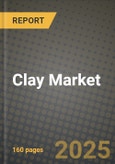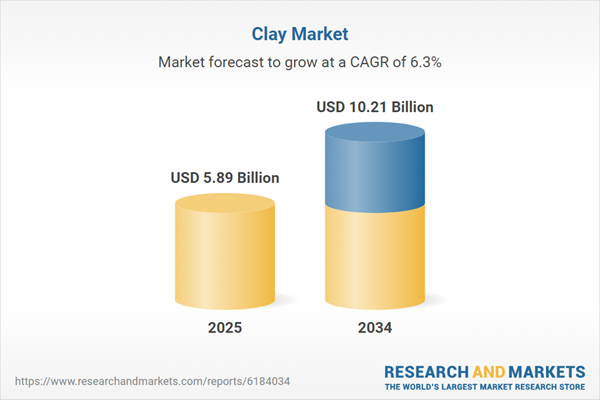Clay Market
The clay market spans a family of industrial minerals - kaolin (china clay), bentonite (sodium/calcium), ball clay, fire clay, attapulgite/palygorskite, and halloysite - processed into hydrous, calcined, delaminated, organo-modified, and specialty grades. Demand is diversified across paper and paperboard coatings and fillers; ceramic tiles, sanitaryware, and tableware; refractories and foundry sands; paints, sealants, and inks; rubber and plastics; drilling fluids and iron-ore pelletizing; animal feed and environmental uses; personal care and cat litter; and emerging cementitious and advanced-materials applications. Key trends include substrate shifts in paper (packaging-led growth vs. graphic decline), premiumization in architectural ceramics, rheology-controlled coatings, and tailwinds from infrastructure and housing cycles. In performance materials, metakaolin advances as a supplementary cementitious material to reduce clinker content, while calcined kaolin and engineered clays improve barrier, brightness, and whiteness in packaging and coatings. Oilfield activity resets bentonite demand in drilling fluids; iron-ore pelletization underpins steady industrial usage. Organoclays and attapulgites refine rheology in paints, sealants, and agriculture. Supply dynamics hinge on ore quality, overburden/stripping ratios, dewatering and tailings management, and beneficiation (blunging, classification, magnetic separation, flotation, delamination, calcination). Logistics - mine-to-mill slurry pipelines, rail, and port access - drive delivered cost. Environmental stewardship and permitting (dust, water balance, land rehabilitation) are central to license-to-operate, while customers increasingly request provenance, energy footprint, and reclamation plans. Competitive differentiation rests on consistent particle-size distribution, brightness/whiteness, low impurity profile (Fe/Ti), rheology control, and application support. Medium-term momentum follows construction and packaging investments, cement decarbonization, and selective high-value niches (HPA feed from kaolin, halloysite nanotubes) weighed against cyclicality in oil & gas and metals.Clay Market Key Insights
- Portfolio matters by application
- Beneficiation as a value lever
- Packaging offsets graphic paper
- Ceramic tile and sanitaryware cycles
- Cement decarbonization pull
- Oilfield and pelletizing fundamentals
- Coatings and rheology engineering
- Purity and brightness premiums
- ESG and license-to-operate
- Logistics and service intensity
Clay Market Reginal Analysis
North America
Strong kaolin reserves support paper, packaging, and specialty coatings, while Wyoming sodium bentonite underpins drilling muds and cat litter. Construction and remodeling sustain ceramic and paint demand; metakaolin adoption grows with low-carbon concrete specs. Rail/port logistics and slurry systems determine cost competitiveness. Buyers emphasize brightness consistency, rheology control, and reliable supply during weather events.Europe
Premium ceramics, sanitaryware, and architectural coatings anchor demand alongside packaging board. Environmental standards drive mine rehabilitation and water recycling; calcined kaolin and metakaolin gain traction in decarbonized cement. Foundry and pelletizing remain steady industrial outlets. Suppliers differentiate through high-whiteness deposits, organoclay portfolios, and technical service close to tile and coating clusters.Asia-Pacific
Largest consumption base with tile megaclusters, sanitaryware hubs, paper/board mills, and active oil & gas provinces. China and Southeast Asia lead tiles and coatings; India scales packaging and cement SCMs. Regional producers invest in beneficiation and calcination to reach export-grade brightness. Logistics proximity to ports and inland rail corridors is critical to landed cost.Middle East & Africa
Construction growth and cement expansion lift metakaolin and ball-clay requirements; oil & gas activity supports bentonite for drilling. Hot, arid environments heighten water-management and dust-control needs at mines. Import reliance for high-brightness kaolin persists, while regional beneficiation projects emerge. Service partners with consistent quality and quick replenishment win share.South & Central America
Infrastructure and housing cycles drive ceramics, cement SCMs, and coatings. Iron-ore corridors underpin bentonite for pelletizing; selective oilfield activity adds drilling-mud demand. Local deposits are upgraded with targeted beneficiation to reduce imports for high-spec grades. Currency and freight volatility favor regional inventories and flexible contracts. Sustainability and community engagement strengthen permit resilience.Clay Market Segmentation
By End-User
- Ceramic
- Non-ceramic
By Application
- Tableware
- Sanitaryware
- Medical applications
Key Market players
Imerys, Sibelco, Thiele Kaolin, KaMin, Huber Engineered Materials, Minerals Technologies (MTI), Clariant, Ashapura Group, Wyo-Ben, Black Hills Bentonite, Tolsa, EP Minerals (U.S. Silica), Quarzwerke Group, EICL (English Indian Clays), 20 MicronsClay Market Analytics
The report employs rigorous tools, including Porter’s Five Forces, value chain mapping, and scenario-based modelling, to assess supply-demand dynamics. Cross-sector influences from parent, derived, and substitute markets are evaluated to identify risks and opportunities. Trade and pricing analytics provide an up-to-date view of international flows, including leading exporters, importers, and regional price trends.Macroeconomic indicators, policy frameworks such as carbon pricing and energy security strategies, and evolving consumer behaviour are considered in forecasting scenarios. Recent deal flows, partnerships, and technology innovations are incorporated to assess their impact on future market performance.
Clay Market Competitive Intelligence
The competitive landscape is mapped through proprietary frameworks, profiling leading companies with details on business models, product portfolios, financial performance, and strategic initiatives. Key developments such as mergers & acquisitions, technology collaborations, investment inflows, and regional expansions are analyzed for their competitive impact. The report also identifies emerging players and innovative startups contributing to market disruption.Regional insights highlight the most promising investment destinations, regulatory landscapes, and evolving partnerships across energy and industrial corridors.
Countries Covered
- North America - Clay market data and outlook to 2034
- United States
- Canada
- Mexico
- Europe - Clay market data and outlook to 2034
- Germany
- United Kingdom
- France
- Italy
- Spain
- BeNeLux
- Russia
- Sweden
- Asia-Pacific - Clay market data and outlook to 2034
- China
- Japan
- India
- South Korea
- Australia
- Indonesia
- Malaysia
- Vietnam
- Middle East and Africa - Clay market data and outlook to 2034
- Saudi Arabia
- South Africa
- Iran
- UAE
- Egypt
- South and Central America - Clay market data and outlook to 2034
- Brazil
- Argentina
- Chile
- Peru
Research Methodology
This study combines primary inputs from industry experts across the Clay value chain with secondary data from associations, government publications, trade databases, and company disclosures. Proprietary modeling techniques, including data triangulation, statistical correlation, and scenario planning, are applied to deliver reliable market sizing and forecasting.Key Questions Addressed
- What is the current and forecast market size of the Clay industry at global, regional, and country levels?
- Which types, applications, and technologies present the highest growth potential?
- How are supply chains adapting to geopolitical and economic shocks?
- What role do policy frameworks, trade flows, and sustainability targets play in shaping demand?
- Who are the leading players, and how are their strategies evolving in the face of global uncertainty?
- Which regional “hotspots” and customer segments will outpace the market, and what go-to-market and partnership models best support entry and expansion?
- Where are the most investable opportunities - across technology roadmaps, sustainability-linked innovation, and M&A - and what is the best segment to invest over the next 3-5 years?
Your Key Takeaways from the Clay Market Report
- Global Clay market size and growth projections (CAGR), 2024-2034
- Impact of Russia-Ukraine, Israel-Palestine, and Hamas conflicts on Clay trade, costs, and supply chains
- Clay market size, share, and outlook across 5 regions and 27 countries, 2023-2034
- Clay market size, CAGR, and market share of key products, applications, and end-user verticals, 2023-2034
- Short- and long-term Clay market trends, drivers, restraints, and opportunities
- Porter’s Five Forces analysis, technological developments, and Clay supply chain analysis
- Clay trade analysis, Clay market price analysis, and Clay supply/demand dynamics
- Profiles of 5 leading companies - overview, key strategies, financials, and products
- Latest Clay market news and developments
Additional Support
With the purchase of this report, you will receive:- An updated PDF report and an MS Excel data workbook containing all market tables and figures for easy analysis.
- 7-day post-sale analyst support for clarifications and in-scope supplementary data, ensuring the deliverable aligns precisely with your requirements.
- Complimentary report update to incorporate the latest available data and the impact of recent market developments.
This product will be delivered within 1-3 business days.
Table of Contents
Companies Mentioned
- Imerys
- Sibelco
- Thiele Kaolin
- KaMin
- Huber Engineered Materials
- Minerals Technologies (MTI)
- Clariant
- Ashapura Group
- Wyo-Ben
- Black Hills Bentonite
- Tolsa
- EP Minerals (U.S. Silica)
- Quarzwerke Group
- EICL (English Indian Clays)
- 20 Microns
Table Information
| Report Attribute | Details |
|---|---|
| No. of Pages | 160 |
| Published | November 2025 |
| Forecast Period | 2025 - 2034 |
| Estimated Market Value ( USD | $ 5.89 Billion |
| Forecasted Market Value ( USD | $ 10.21 Billion |
| Compound Annual Growth Rate | 6.3% |
| Regions Covered | Global |
| No. of Companies Mentioned | 15 |









